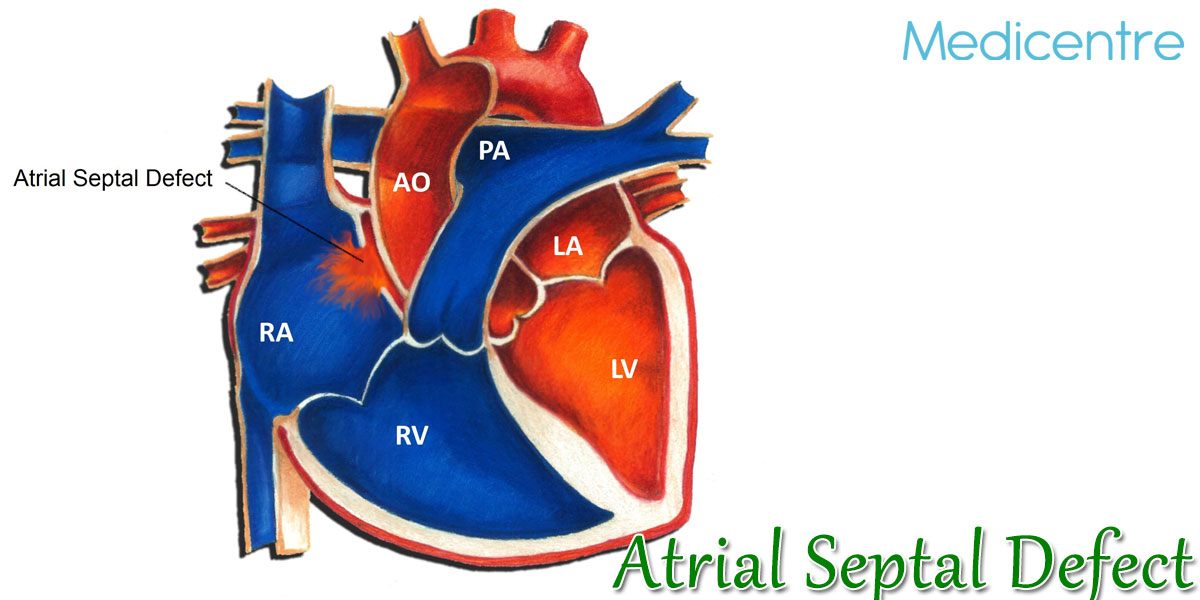Atrial Septal Defect
Atrial Septal Defect or ASD is the medical condition which is characterized by a hole in the wall between two upper chambers of heart. This medical condition is primarily available right from birth. They are distinguished as small ASD and larger ASD where the small ASD closes by its own over the time period of early childhood or infancy, However, the larger AS is the long lasting condition which tends to damage the lungs and heart if left untreated and may prove to be fatal as well. Small ASD may also cause issues which are found incidentally. Patients with undetected ASD for several years usually have short lifespan and may experience heart failure and high blood pressure. Surgery is the only option to repair the defects and prevent the complications associated with it.

What are the Symptoms of Atrial Septal Defect?
Many infants born with Atrial Septal Defect usually show not symptoms and in adults the signs start showing up after the age of 30 years. In most of the cases signs may not occur until several decades. Some of the common symptoms of Atrial Septal Defect are:
- Fatigue
- Shortness of breathing while working
- Recurrent Lung infections
- Swelling in legs, abdomen and feet
- Skipped beasts or heart palpitations
- Heart murmur
- Stroke
Causes of Atrial Septal Defect
According to doctors, the Atrial Septal Defect occurs during birth of the baby and it is caused in the heart development phase of pregnancy. However, the obvious cause of Atrial Septal Defect is still not clear. Environmental factors and genetics play a major role in causing ASD.
Due to ASD freshly oxygenated blood is pumped from left upper chamber of heart into right upper chamber of heart and they are mixed up with de-oxygenated blood and again pumped to lungs even though it is already refreshed with oxygen. When the ASD is larger, the excessive blood volume overfills the lungs and makes your heart to work harder. When it is left untreated, the right side of the heart expands and weakens. When the process persistent for longer, the blood pressure in lungs is enhanced significantly leading to pulmonary hypertension.
Risk Factors of Atrial Septal Defect
It is not clear when Atrial Septal Defect is caused, but congenital heart defects tend to appear to run in families and sometime it occurs with some other genetic disorders like Down syndrome. If anyone in the parents or siblings having heart defects, the chances of having Atrial Septal Defect in future child increases. Some of the conditions which may trigger the condition of Atrial Septal Defect during pregnancy include:
- Rubella infection
- Diabetes or lupus
- Drug, tobacco, alcohol use or exposure to certain substances
- Obesity
- Phenylketonuria
Some of the complications of Atrial Septal Defect include:
The large Atrial Septal Defect may cause mild to fatal problems including:
- Heart rhythm abnormalities
- Right-sided heart failure
- Increased risk of stroke
Some of the less common serious complications are:
- Pulmonary hypertension
- Eisenmenger Syndrome
There are treatments which can reduce these complications and manage them well.
Diagnose of Atrial Septal Defect
Doctors can determine the presence of Atrial Septal Defect or other heart defects in the regular checkups when they hear a heart murmur through their stethoscope. It can also be found with a ultrasound examination of heart. Doctor may also conduct other tests to find out Atrial Septal Defect and they usually recommend the further tests when they suspect for Atrial Septal Defect. Some of the tests performed are:
- Chest X-Ray
- Echocardiogram
- Electrocardiogram
- Cardiac Catheterization
- Magnetic Resonance Imaging
- Computerized Tomography
Treatments for Atrial Septal Defect
Most of the small Atrial Septal Defect usually close on its own during early childhood, while some of the larger Atrial Septal Defect require a surgery to repair and close the hole. There are no medications available to repairing the hole. Surgery is the only option that can repair the medium to large sized Atrial Septal Defect. In case of severe pulmonary hypertension, surgery is not prescribed. There are two surgical procedure prescribed for repairing the hole:
- Cardiac Catheterization
- Open Heart Surgery